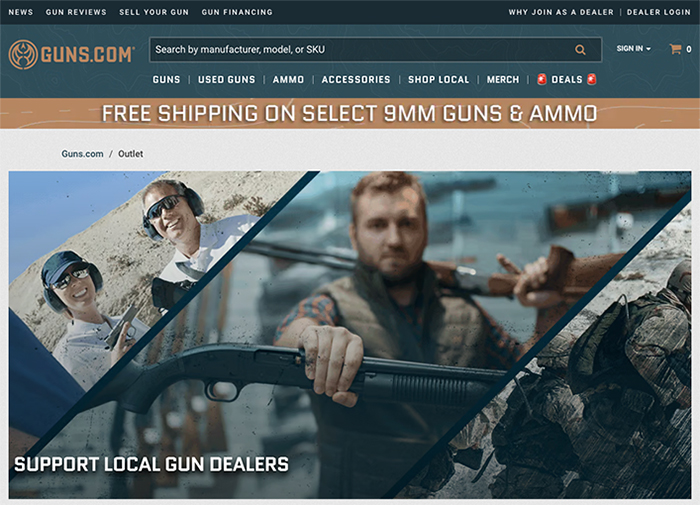The Roadmap To
Marketing Success
There’s no wrong time to create an annual marketing plan, but with the new year quickly approaching, goal-setting is at the forefront of many people’s minds.
An annual marketing plan is an important, over-arching benchmark outlining your marketing goals for the next 12 months. You might be thinking, “I’ve never created a formal plan before and my business has still been successful” — and you’re not alone.
A 2019 study revealed 50% of small and medium business owners did not have a marketing plan.1 The vast majority (86%) said they would rather spend their time on other business activities than spending time on marketing. Additionally, 55% said they spend less than 5% of their annual revenue on marketing.
This year and last, many firearms and shooting retailers experienced record-breaking sales volume in part to the pandemic and political climate. Coupled with strained supply chains from increased demand and manufacturing disruptions, marketing became even less of a priority.
But for those who want to retain their sudden influx of new customers and continue to grow, an annual marketing plan can be the roadmap to help you do so. Creating one isn’t as daunting as some may think.
Audience Research
Market research is the foundation of the entire plan. Investing time and resources into this step will help make sure you understand the motivations, pain points, needs and concerns about your current target market, as well as any new consumer segments you want to tap into.
Take the time to analyze all of the data at your disposal: customer feedback surveys, social media and email newsletter data, website metrics and sales data. This will help build buyer personas — semi-fictional representations of an ideal customer based on market research and real data about existing customers — to guide sales and marketing strategies.
For example, how you market to Joe, a 60-year-old retired law enforcement officer who spends his free time hunting, fishing and camping, will be drastically different than how you market toward Jennifer, a 25-year-old single mom who has never held a gun in her hands, much less fired one.
Assess The Market
For this step, you’ll evaluate the current state of the firearms and/or outdoor industry overall. This is also when your competitors are defined and where your brand stands within the market. Leaving no stone unturned, you may consider hiring a marketing agency to help. What you spend in money, will undoubtedly be saved in time.
If you don’t have the resources to outsource or just prefer to go the do-it-yourself route, Hubspot offers a free downloadable SWOT analysis template to help identify your business’ strengths, weaknesses, opportunities and threats. They also offer a free, interactive tool to help generate a full 12-month marketing plan.
(For more info on each, visit blog.hubspot.com/marketing/swot-analysis and hubspot.com/marketing-plan-template-generator.)
Make sure all of your marketing initiatives are directly tied to one or more of your goals.
Write SMART Goals
You probably already had some goals in mind before starting this process. Sometimes it’s easier to start with the end in mind, then work backward to figure out how to get there. Use this stage to evaluate goals against the latest marketplace realities.
With ample market and audience research in hand, it will be easier to determine what marketing objectives will matter the most over the next 12 months. Realistically, you should focus on no more than three to five goals. Want to increase leads and customer conversions? Increase revenue from existing customers? Increase sales of shotguns and rifles versus handguns? Grow website traffic?
Whatever they are, make sure goals are specific, measurable, attainable, relevant and time-bound (SMART). Don’t just set a goal of increasing online sales, but rather something like decreasing the percentage of abandoned online carts by 10% in six months.
Determine Your Tactics
You’ve determined goals based on the target audience and current situation. Now, it’s time to determine what tactics will help you achieve them.
Let’s go back to the example of decreasing the percentage of abandoned online carts by 10% in six months.
A first step could be using a heatmap and behavior-analytics tool like Hotjar (hotjar.com) to see exactly what users are clicking on and at what point they stop before completing the checkout process. You might discover small tweaks that could improve the user experience.
Another tactic could be implementing a retargeting strategy, so those who abandoned their online shopping cart receive an “It looks like you forgot something” email along with a promo code for a small discount or free shipping.
The important thing here is to make sure all of your marketing initiatives are directly tied to one or more of your goals.
Set Your Budget
If your store or range doesn’t have a designated marketing budget, it’s time to set one. This budget should account for any expenses needed to pursue the goals and initiatives outlined in earlier steps.
Line items to consider include hiring in-house marketing staff, outsourcing costs to a marketing agency and/or other providers, marketing software, paid promotion and events you’ll either host or attend.
There are a few metrics you can use to determine a budget. A recent article from Forbes outlines three:
(1) cost of advertising, (2) revenue per customer or (3) percentage of your total revenue.2 The article mentions a bonus method — what you’re able to afford.
Be Flexible
Creating an annual marketing plan will help determine your priorities and make everyone’s job a lot easier, but it’s important to remember your plan shouldn’t be set in stone. Instead, think of it as a roadmap. Use it to guide you through an ever-changing landscape. Carve out time each week (or each month) to keep an eye on market research industry trends, and how your business is progressing toward its goals.
At some point along the way, you’ll likely need to make adjustments to make sure the strategies and tactics being used are driving the results your marketing should see.
Key takeaway
If your store or range would like to grow in 2022, marketing will need to be a priority, not an afterthought. Treat it as an investment by taking the time to develop a research-backed annual marketing plan. Doing so will help ensure you’re making the most of every resource, every dollar and every minute.
Footnotes:
1 https://bit.ly/3B3rMRW
2 https://bit.ly/3jiH3Iq





